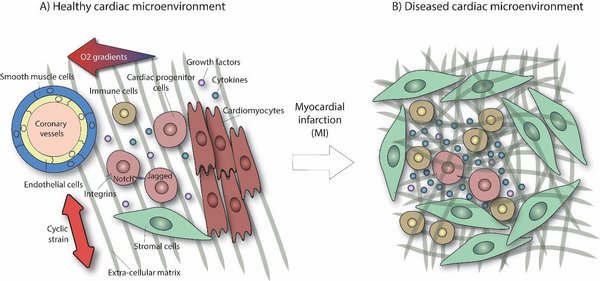Description
Upon myocardial infarction, healthy myocardium at the site of injury is affected massively, resulting in not only a huge loss of cardiomyocytes but also in a loss of cardiac structural organization (Figure 1). Presently, cardiac regenerative strategies focus on restoring the number of cardiomyocytes without taking into account restoring the structural cardiac organization. Despite promising short term effects, long term results have been largely disappointing, suggesting the importance of not only restoring the number of cells but also their micro-environment. In this PhD project, we aim to understand cardiac structural tissue organization to ultimately study if and how we can restore this organization after cardiac injury. In order to do so, we aim to investigate if cardiac cells can be organized using anisotropic mechanical cues and how active contractility of beating cardiac cells affects cellular and tissue organization in 2D and 3D. Ultimately, we intent to use this knowledge to explain what we see happening in the developing or injured human heart. Moreover, we aim to build a 3D in vitro myocardial wall model that consists of a cardiac cell population embedded in a native like ECM together with the mechanical cues present in the heart in order to investigate whether it would be possible to restore structural cardiac tissue organization by providing the right biomechanical cues.
Researchers
Researcher: D. (Dylan) Mostert.
Supervisors: E.L. (Leda) Klouda, C.V.C. (Carlijn) Bouten.
Funding by the Nederlandse Organisatie voor Wetenschappelijk Onderzoek (NWO) within the Materials Driven Regeneration (MDR) consortium.

Contact
-
Ir. D. Mostert
-
Dr. E.L. Klouda
-
Prof.dr. C.V.C. Bouten